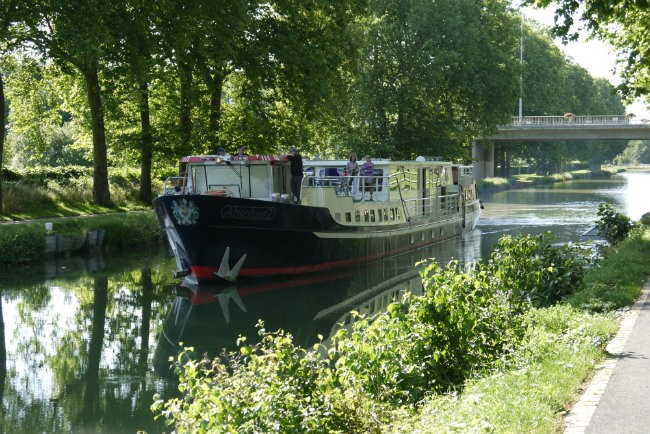The Hemingway Adventure: Visiting Burgundy on a Luxury Canal and River Barge

Burgundy. The name conjures up a beautiful image, one of rolling hills, expansive vineyards, and picturesque waterways calmly flowing through the countryside. Châteaux and villages rise above the water, beautifully quaint and strikingly different from any sight you’ve seen before. Beauty surrounds you from all sights and captivates the senses. The sights are beautiful, the cuisine divine, the wine seductive. It is a vacation unlike any you have experienced before. And the best way to enjoy the region is aboard a luxury barge like the Hemingway, a freshly refit yacht that cruises the Saône and the many canals winding through the Burgundian countryside.
The Hemingway seeks to give its guests the ultimate in luxury as they cruise Burgundy. Personalized itineraries cater to every interest, and an onboard chef brings Burgundian cuisine to life with fresh, market-fresh ingredients, without having to venture away from the palatial comfort Hemingway offers. If you do choose to venture away from Hemingway, use one of the bikes stored onboard to ride to the next lock on the canal, or simply walk the towpath as the barge meanders in the waters alongside you.
But why travel to Burgundy? In short, the historic region is an ideal place for a relaxing vacation different from other cruises. History, recreation, cuisine, and wine all come together for a majestic experience fitting the royalty who once ruled this beautiful region.
Burgundy has a long and storied history, dating back to the days of the Roman Empire. Established as a kingdom by Scandinavian descendants at the western edge of the Roman Empire, the early Burgundians paid tribute and served auxiliaries until the Empire’s decline. Kingdoms came and went, foreign rulers occupied and retreated, and dukes rose to rule the region. The rule of the various Dukes of Burgundy was a golden age, bringing Dijon to power as a market hub — which it remains today. And all the while, the Benedictine and Cistercian monks were producing some of the finest wines in the world. The Hemingway includes several wine tastings and vineyard tours in its itineraries so you can appreciate the monks’ art form for yourself.
Dijon remains a market center today, with its main market — designed by Gustave Eiffel himself in his signature wrought iron — a bustling hub of vendors selling the greatest variety of food products imaginable! Vendors sell food ranging from fresh fruit and produce to delicious pastries, tantalizing cheeses, and poultry. Tuesdays are traditionally market day, and the activity in the center of town brings Dijon to life. Other vendors sell all sorts of goods, from handbags to shoes, making a shopping trip in Dijon a must for any traveler. The fresh food doesn’t end at the vendors — restaurants line the town square, serving incredible food. A lunch break is as much an experience as the shopping. The flexible itineraries of the Hemingway ensure plenty of time to explore the market while touring Dijon.
To Dijon’s southwest sits a second historic city, Beaune. The true heart of the Burgundian wine trade, Beaune remains home to nearly-uncountable wine cellars. The historic Hôtel Dieu, a former charity hospice, remains a major component of the local trade as site of an annual charity wine auction. The Museum of Burgundy Wines, housed in the former residence of the Dukes of Burgundy, is a must-see for wine aficionados and novices alike. The rich history of Burgundy truly comes alive in Beaune. Guided tours provided by Hemingway’s knowledgeable staff give ample opportunity to learn about Beaune’s rich history firsthand.
Winemaking, naturally, remains a critical component of the local economy. Thomas Jefferson once spent five days touring the region and arranging for supplies of Burgundy wines for the legendary cellars of Monticello. Historical record has provided evidence for wine production dating to the first century B.C. by Celts, but the region’s winemaking history truly began with Benedictine monks affiliated with the Roman Catholic Church. The monks took a role at the forefront of Burgundian wine production, with the Cistercians in particular devoting considerable attention to the growth and cultivation of the vine. Cistercian attention to detail and patience put Burgundy on the map; Clos de Vougeot, one of the Cistercian’s numerous walled vineyards, continues the tradition today, and remains one of the best labels in the Côte d’Or.
Red wines today are mostly Pinot Noir varietals, which originated with a decree in 1395 by Duke Philip the Bold declaring the Gamay grape — the other major red varietal grown in the region — unfit for human consumption. The white wines in the region are largely Chardonnay, particularly in Chablis to the north and in the southern Côte du Beaune. Many local vineyards, descendants of long, proud traditions dating back centuries, continue wine production in the many cellars throughout the region. Beaune has cellars throughout the city, many of which constitute hidden gems for those in the know locally, where a wine aficionado could spend hours tasting wines from across Burgundy.
The cuisine of Burgundy is another essential experience for any traveler to the region. The Dijon market is a critical centerpiece of Burgundy gastronomy. The many chefs of the area rely on the marketplace for fresh ingredients for meal preparation. The legendary Maille boutique has sold mustard since the eighteenth century from a street corner shop in the heart of Dijon, and is an absolute must for anyone passing through the city.
The unique culinary traditions are visible outside of Dijon as well. Beef is a major staple of Burgundy cuisine, and the rolling hills of the Burgundy countryside would not be complete without the many Charolais cattle grazing. The careful regime used to raise the cattle results in a tender, flavorful beef that defies description. The signature dish of the region, Boeuf Bourguignon, is an art in itself that requires two days of preparation using locally produced red wines and Charolais beef. Enjoying the dish with a Burgundy red is an unsurpassable culinary delight, and Hemingway’s onboard chef brings local dishes directly to the dining table for your personal enjoyment.
Burgundy has much to offer the traveler, be it a foodie, a wine connoisseur, a self-declared history buff, or a simple adventurer. Restored barges and yachts, often owner-operated directly, offer a comfortable way to experience Burgundy. A barge cruise offers a comfortable, relaxed way to see the countryside, feet kicked up and a drink in hand. The luxury accommodations and personal, professional service provided by the owners gives their guests the feel of a luxury hotel, as well as transportation through the countryside to Dijon, Beaune, and elsewhere. Customized itineraries can cater to many tastes. Perhaps a wine-focused itinerary for a discerning connoisseur that has prearranged tours to the region’s best labels? Or perhaps an itinerary customized for a golfer, with tee times daily at the region’s picturesque courses? Perhaps a mix of everything? A relaxing cruise through a scenic, historic region. A casual bike ride along the winding towpath to meet the barge at the next lock on the canal. A hot air balloon ride to see Burgundy from the sky. These adventures, and more, are possible on a barge cruise aboard the Hemingway.
Whatever your interest, a Burgundian barge cruise is the vacation you need. Come and see the world differently with us! Burgundy is waiting!
The Hemingway is a luxury charter yacht that cruises Burgundy. Visit online at www.hemingwaycruises.com, or call directly at (888) 474-2849.
Sponsored article
Share to: Facebook Twitter LinkedIn Email



